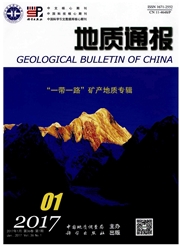

 中文摘要:
中文摘要:
在详细野外调研的基础上,对位于太行山南段洪山岩体中粗面斑岩的岩石学、地球化学和年代学特征进行了研究。该区斑岩中Si O2含量为63.57%~67.85%,平均为65.19%;里特曼指数σ值为5.6~8.2;K2O/Na2O为1.00~1.74,平均为1.24;A12O3为16.75%~18.77%,平均为18.21%。铝饱和指数A/CNK为1.00~1.06,属于碱性正长岩类岩石。岩石稀土元素总量(∑REE)为33.75×10-6~144.30×10-6,(La/Yb)N=9.18~33.28,呈现轻稀土元素(LREE)富集、重稀土元素(HREE)相对亏损的特点。δEu=0.99~1.16,有微弱正Eu异常。在原始地幔标准化微量元素蜘蛛图解中,样品均显示强烈富集大离子亲石元素(LILEs)、相对亏损高场强元素(HFSEs)的特征。同时,在该地区获得的粗面斑岩LA-ICP-MS锆石U-Pb年龄为128.6±1.0Ma。锆石εHf(t)值为-16.0~-11.4,对应的地壳模式年龄(TDM)为1258~1432Ma。这些数据表明,洪山粗面斑岩与洪山其他中生代侵入岩是同期岩浆作用的产物,形成于早白垩世由造山挤压环境向伸展环境转变期,是EM1型富集地幔部分熔融形成富碱的岩浆上升侵位,并受古老下地壳物质混染形成的。华北规模庞大的中生代岩浆作用可能与部分熔融并消耗富集岩石圈地幔层有关,这可能也是岩石圈地幔减薄的重要方式之一。
 英文摘要:
英文摘要:
Based on detailed field investigation, the authors studied the petrology, geochemistry and geochronology of trachyte por- phyry in Hongshan intrusion. The SiO2 and A1203 of the rock range from 63.57% to 67.85% and 16.75% to 18.77%, 65.19% and 18.21% on average respectively. Rittmann index (σ) ranges 5.6-8.2, the K2O/Na2O ratio ranges 1.00-1.74, with an average of 1.24. A/CNK varies from 1.00 to 1.06. These data suggest that it belongs to alkaline syenite rock. The REE content is between 33.75-10 6 and 144.30×10^-6, with (La/Yb)N ratios of 9.18-33.28 and δ Eu of 0.99-1.16. The intrusion is remarkably characterized by enriched LREE and depleted HREE. The chondrite-normalized REE patterns show weak positive Eu anomaly. In the primitive mantle nor-malized trace element spider diagrams, the samples show strong enrichment of LILEs and relative depletion of HFSEs. In addition, tra- chyte porphyry's LA-ICP-MS zircon U-Pb dating indicates that the trachyte porphyry were emplaced at ca.128.6±1.0Ma. The zircon ε.Hf(t) values (-16.0- -11.4) yielded zircon Hf crustal modal ages of 1258-1432Ma. Based on the data obtained, the authors hold that Hongshan volcanic rocks originated from partial melting of an EMI-type mantle source, contaminated by LCC. Trachyte por- phyry formed in the same time as the Hongshan intrusion in the Mesozoic Cretaceous. Magmatic activities took place in the transfor- mation period of the collision environment, causing the partial melting of the mantle and producing the trachyte porphyry. This might have been one of the important ways oflithospheric mantle thinning.
 同期刊论文项目
同期刊论文项目
 同项目期刊论文
同项目期刊论文
 Discovery and geological significance of telluride minerals in the Yinggezhuang gold deposit, Rushan
Discovery and geological significance of telluride minerals in the Yinggezhuang gold deposit, Rushan Low-Al and high-Al trondhjemites in the Huai'an Complex, North China Craton: Geochemistry, zircon U-
Low-Al and high-Al trondhjemites in the Huai'an Complex, North China Craton: Geochemistry, zircon U- Stable isotopes and noble gases in the Xishimen gold deposit, central North China Craton: metallogen
Stable isotopes and noble gases in the Xishimen gold deposit, central North China Craton: metallogen Mesozoic magmatism and metallogenesis associated with the destruction of the North China Craton: Evi
Mesozoic magmatism and metallogenesis associated with the destruction of the North China Craton: Evi Source characteristics and fluid evolution of the Beiyingxigou Pb-Zn-Ag deposit, central North China
Source characteristics and fluid evolution of the Beiyingxigou Pb-Zn-Ag deposit, central North China Charateristics of the genetic mineralogy of pyrite and its significance for the prospecting in the D
Charateristics of the genetic mineralogy of pyrite and its significance for the prospecting in the D Laser probe 40Ar-39Ar dating for quartz from auriferous quartz veins in the Shihu gold deposit, west
Laser probe 40Ar-39Ar dating for quartz from auriferous quartz veins in the Shihu gold deposit, west The Beiminghe skarn iron deposit, eastern China: Geochronology, isotope geochemistry and implication
The Beiminghe skarn iron deposit, eastern China: Geochronology, isotope geochemistry and implication THERMOLUMINESCENCE (TL) ANALYSIS FOR OTOLITHS OF THE WILD CARPS (CYPRINOID) FROM BAIYANGDIAN LAKE AN
THERMOLUMINESCENCE (TL) ANALYSIS FOR OTOLITHS OF THE WILD CARPS (CYPRINOID) FROM BAIYANGDIAN LAKE AN Significance of zircon trace element geochemistry, the Shihu gold deposit, western Hebei Province, N
Significance of zircon trace element geochemistry, the Shihu gold deposit, western Hebei Province, N ISOTOPE GEOCHEMISTRY OF THE SHIHU GOLD DEPOSIT, HEBEI PROVINCE, NORTH CHINA: IMPLICATION FOR THE SOU
ISOTOPE GEOCHEMISTRY OF THE SHIHU GOLD DEPOSIT, HEBEI PROVINCE, NORTH CHINA: IMPLICATION FOR THE SOU Geochronology and petrogenesis of Neoarchean potassic meta-granites from Huai';an Complex: Implicati
Geochronology and petrogenesis of Neoarchean potassic meta-granites from Huai';an Complex: Implicati Laser Ablation ICP-MS U-Pb Zircon Geochronology of Granitoids and Quartz Veins in the Shihu Gold Min
Laser Ablation ICP-MS U-Pb Zircon Geochronology of Granitoids and Quartz Veins in the Shihu Gold Min Geodynamics of gold metallogeny in the Shandong Province, NE China: An integrated geological, geophy
Geodynamics of gold metallogeny in the Shandong Province, NE China: An integrated geological, geophy Oxygen, boron, chromium and niobium enrichment in native Au and Ag grains: A case study from the Lin
Oxygen, boron, chromium and niobium enrichment in native Au and Ag grains: A case study from the Lin Magmatism and metallogeny associated with mantle upwelling: Zircon U-Pb and Lu-Hf constraints from t
Magmatism and metallogeny associated with mantle upwelling: Zircon U-Pb and Lu-Hf constraints from t Metallogeny in response to lithospheric thinning and craton destruction: Geochemistry and U-Pb zirco
Metallogeny in response to lithospheric thinning and craton destruction: Geochemistry and U-Pb zirco Geochemistry, and zircon U-Pb and molybdenite Re-Os geochronology of Jilongshan Cu-Au deposit, south
Geochemistry, and zircon U-Pb and molybdenite Re-Os geochronology of Jilongshan Cu-Au deposit, south 期刊信息
期刊信息
